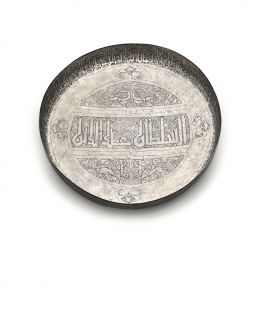Silver Tray
Iran11th Century
Iran, 11th century. Silver; hammered and chased. An important inscription furnishes the name of its owner and the date, and indicates that it was a gift to the Sultan Alparslan. The inscription reads as follows:
"A present to his Most Exalted Majesty, the Sultan Alp Arslan, May Allah make his reign long: ordered to be made by the august queen, the cynosure of all married women in the state, and executed by Hasan of Kashan in the year459 (1066-7)."
The tray is decorated in the center by a round medallion separated into three parts by two bands with central knots. Palmettes frame the medallion at the top, bottom and sides. The middle section is the largest, and contains an inscription in kufic naming the Sultan. The background area of the inscription band is filled with floral motifs and spiral arabesques. The upper section shows two confronting birds, perhaps peacocks, with their heads arched back. Palmettes surround the birds. in the lower section, two confronting mythological horned beasts are depicted, their heads turned to the rear. The beasts have the head of an ibex, the body of a lion and the wings of an eagle. This is a commonly-seen figure in Sassanian art. Palmettes and stylized vegetal motifs surround the figures. A Kufic inscription band circles the inner edge of the tray.
This stunning silver tray is important as it provides the name of its owner and donor. in addition, this tray is interesting as it was commissioned by a woman, probably Arslan Hatun, the sister of the Sultan, or perhaps by the Sultan's wife Kalif Kayım, in honor of Sultan Alparslan's achievements against his brother Kara Arslan, who rebelled in the city of Kinman lstahr in 1067 (Pope, 1933, 229).

